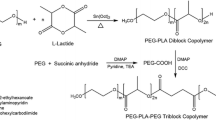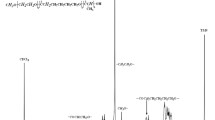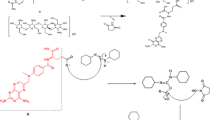Abstract
Purpose. To study the effects of hydrophobicity of the micelle-formingblock copolymeric drug conjugate, methotrexate (MTX) esters ofpoly-(ethylene oxide)-block-poly(2-hydroxyethyl-L-aspartamide) (MTXesters of PEO-b-PHEA), on the stability of micelles and on drug release.
Methods. MTX esters of PEO-b-PHEA with three levels of MTXconjugation were synthesized. Size distribution of the micelles wasmeasured by dynamic light scattering (DLS). The critical micelleconcentration (CMC) was determined by a light scattering study. Sizeexclusion high performance liquid chromatography (SEC-HPLC) wasused to study the equilibrium between unimers and micelles, and releaseof MTX at pH 7.4.
Results. MTX esters of PEO-b-PHEA with MTX substitution of 7.4%,22%, and 54% were prepared. The conjugates formed micelles basedon DLS. The stability of the micelles correlated with the level of MTXconjugation. The conjugate with 54% MTX had a lower CMC (0.019mg/mL) than the conjugates with 22% MTX (0.081 mg/mL) or 7.4%MTX (0.14 mg/mL). Micelle dissociation was significantly slower forthe conjugate with 54% MTX than that with 22% and 7.4% MTX.Slower release of MTX from the micelles was also observed for theconjugate with the higher MTX attachment.
Conclusions. MTX esters of PEO-b-PHEA can be structurallymodulated by varying the degree of MTX substitution, which in turn changesthe hydrophobicity of the conjugate, thereby modifying micelle stabilityand controlling drug release.
Similar content being viewed by others
REFERENCES
C. Allen, Y. Yu, D. Maysinger, and A. Eisenberg. Polycaprolactone-b-poly(ethylene oxide) block copolymer micelles as a novel drug delivery vehicle for neurotrophic agents FK506 and L-685,818. Bioconjugate Chem. 9:564–572 (1998).
K. Kataoka, G. S. Kwon, M. Yokoyama, T. Okano, and Y. Sakurai. Block copolymer micelles as vehicles for drug delivery. J. Controlled Release. 24:119–132 (1993).
X. Zhang, J. K. Jackson, and H. M. Burt. Development of amphiphilic diblock copolymers as micellar carriers of taxol. Int. J. Pharm. 132:195–206 (1996).
G. S. Kwon, M. Naito, M. Yokoyama, T. Okano, Y. Sakurai, and K. Kataoka. Micelles based on ab block copolymers of poly(ethylene oxide) and poly(β-benzyl l-aspartate). Langmuir 9:945–949 (1993).
K. Kataoka. Targetable polymeric drugs. In K. Park (ed.) Controlled Drug Delivery: Challenges and Strategies, American Chemical Society, Washington, D.C., 1997, pp. 49–71 (1997).
M. Y. Gorshkova and L. L. Stotskaya. Micelle-like macromolecular systems for controlled release of daunomycin. Polymers for Advanced Technologies 9:362–367 (1998).
M. Yokoyama, T. Sugiyama, T. Okano, Y. Sakurai, M. Naito, and K. Kataoka. Analysis of micelle formation of an adriamycin-conjugated poly(ethylene glycol)-poly(aspartic acid) block copolymer by gel permeation chromatography. Pharm. Res. 10:895–899 (1993).
R. Nagarajan, M. Barry, and E. Ruckenstein. Unusual selectivity in solubilization by block copolymer micelles. Langmuir 2:210–215 (1986).
G. S. Kwon, M. Y. Suwa, T. Okano, Y. Sakurai, and K. Kataoka. Physical entrapment of adriamycin in ab block copolymer micelles. Pharm. Res. 12:192–195 (1995).
M. Yokoyama, T. Okano, Y. Sakurai, H. Ekimoto, C. Skibazaki, and K. Kataoka. Toxicity and antitumor activity against solid tumors of micelle-forming polymeric anticancer drug and its extremely long circulation in blood. Cancer Res. 29:17–23 (1991).
Y. Li and G. S. Kwon. Micelle-like structures of poly(ethylene oxide)-block-poly(2-hydroxyethyl aspartamide)-methotrexate conjugates. Colloids Surf. B: Biointerfaces 16:217–226 (1999).
M. Yokoyama, S. Inoue, K. Kataoka, N. Yui, and Y. Sakurai. Preparation of adriamycin-conjugated poly(ethylene glycol)-poly-(aspartic acid) block copolymer: a new type of polymeric anticancer drug. Macromol. Chem. Rapid Commun. 8:431–435 (1987).
L. Zhang, H. Shen, and A. Eisenberg. Phase separation behavior and crew cut micelle formation of polystyrene-b-poly(acrylic acid) copolymer in solutions. Macromolecules 30:1001–1011 (1997).
P. Tancrede, J. Barwicz, S. Jutras, and I. Gruda. The effect of surfactants on the aggregation state of amphotericin B. Biochim.-Biophys. Acta 1030:289–295 (1990).
N. J. Yurro, M. Gratzel, and A. M. Braun. Photochemical processes in micellar system Angew. Chem. Int. Ed. Engl. 19:675–696 (1980).
Author information
Authors and Affiliations
Rights and permissions
About this article
Cite this article
Li, Y., Kwon, G.S. Methotrexate Esters of Poly(Ethylene Oxide)-Block-Poly(2-Hydroxyethyl-L-Aspartamide). Part I: Effects of the Level of Methotrexate Conjugation on the Stability of Micelles and on Drug Release. Pharm Res 17, 607–611 (2000). https://doi.org/10.1023/A:1007529218802
Issue Date:
DOI: https://doi.org/10.1023/A:1007529218802




